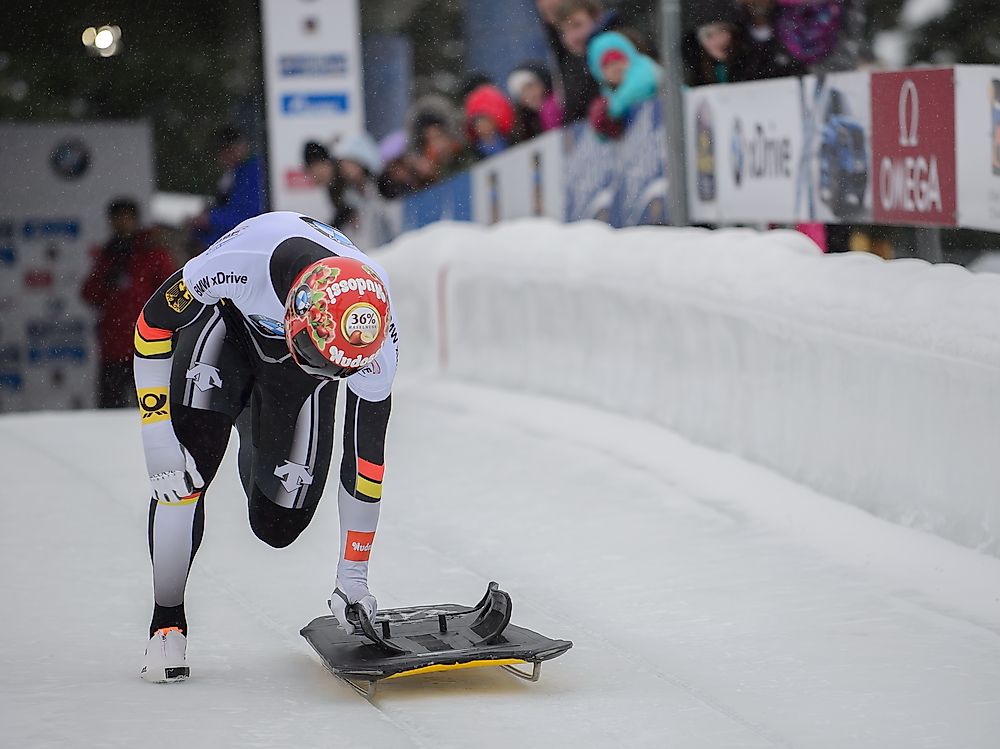Winter Olympic Games: Skeleton

Skeleton racing is a winter athletic sport that involves an athlete sliding down a steep ice track with their head down on a sled. The sleds have a bony, skeleton-like appearance hence the name Skeleton. The sport is still referred to by its original name, tobogganing, in many countries. Unlike other winter sports like luge and bobsleigh, in the skeleton only one athlete races at a single particular time. The race begins with the athlete running from the beginning of the ice track before they start sliding on their sleds. The sleds must be made of steel, however, plastic could be used to make the base of the sled. On the side of the sleds, there are handles and bumpers to boost the safety of the athlete during the race.
History of Winter Olympic Skeleton
Skeleton was first practiced by the English soldiers in 1882. The British soldiers constructed a toboggan track with curves and bends between the towns of Davos and Klosters, which they used to race against themselves. Major William Bulpett and Casper Badrutt constructed a Cresta run in 1884. The ¾ mile Cresta Run was constructed in 1884, between the towns of St Moritz and Celerina. The Cresta run has ten turns and it is still used to date. In fact, the Cresta run was used in the winter Olympics of 1928 and 1948.
In 1887, the head first sledding was introduced by Mr. Cornish and adapted by many other racers. In 1892, L.P Child designed the first skeleton-like sled. Until 1905, the sport was mainly practiced in Switzerland. The Federation Internationale de Bobsleigh et Tobogganing was established in 1923 to cater and govern the skeleton. Although the sport continued to spread, it was not added to the list of Olympic sports until 2002. After 2002, skeleton’s popularity increased with some countries whose climate cannot allow the formation of ice also taking part in the sport.
Rules of Skeleton Racing
For an athlete to take part in skeleton racing, he or she is required to have an alpine racing helmet which consists of a chin guard, skin-tight racing costume, goggles, elbow and shoulder pads, spiked shoes, and a sled. The maximum sled’s weight must be 43 kg for men and 35 kg for women. The combined weight of the athlete and racing equipment should not exceed 115 kg for men and 92 kg for women. If the weight exceeds the maximum, the men’s sled weight is reduced to 33 kg and women's sled weight is reduced to 29 kg. However, to attain maximum weight, athletes are allowed to add ballast weights. The athlete is expected to cross the finish line while still on the sled. However, they are allowed to leave the sleds a little earlier before the finish line and pull or push it.
Skeleton Crashes
Skeleton racing can be dangerous and in some instances, it has caused a loss of lives. The speed at which the racers move can cause fatal accidents. Nodar Kumaritashvili, a Georgian based athlete, lost control while training and hit steel objects. He sustained serious injuries and later succumbed to death. Other deaths caused by the sport include Ross Milne and Kazimierz Kay-Skrzypeski in 1964 and Nicholas Bochatay in 1992.











